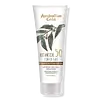What's inside
What's inside
 Key Ingredients
Key Ingredients

 Benefits
Benefits

 Concerns
Concerns

 Ingredients Side-by-side
Ingredients Side-by-side

Titanium Dioxide 4%
Cosmetic ColorantZinc Oxide 4%
Cosmetic ColorantAlumina
AbrasiveButyrospermum Parkii Butter
Skin ConditioningCaprylyl Glycol
EmollientCetyl PEG/PPG-10/1 Dimethicone
EmulsifyingCyclopentasiloxane
EmollientDimethicone Crosspolymer
Emulsion StabilisingDisodium EDTA
Disteardimonium Hectorite
StabilisingEucalyptus Globulus Leaf Extract
PerfumingGlycerin
HumectantHexyl Laurate
EmollientIron Oxides
Panthenol
Skin ConditioningPEG-10 Dimethicone
Skin ConditioningPhenoxyethanol
PreservativePolyglyceryl-4 Isostearate
EmulsifyingPolymethylsilsesquioxane
Porphyra Umbilicalis Extract
Skin ConditioningSilica
AbrasiveSqualane
EmollientStearic Acid
CleansingTerminalia Ferdinandiana Fruit Extract
AntioxidantTocopheryl Acetate
AntioxidantTriethoxycaprylylsilane
Water
Skin ConditioningTitanium Dioxide 4%, Zinc Oxide 4%, Alumina, Butyrospermum Parkii Butter, Caprylyl Glycol, Cetyl PEG/PPG-10/1 Dimethicone, Cyclopentasiloxane, Dimethicone Crosspolymer, Disodium EDTA, Disteardimonium Hectorite, Eucalyptus Globulus Leaf Extract, Glycerin, Hexyl Laurate, Iron Oxides, Panthenol, PEG-10 Dimethicone, Phenoxyethanol, Polyglyceryl-4 Isostearate, Polymethylsilsesquioxane, Porphyra Umbilicalis Extract, Silica, Squalane, Stearic Acid, Terminalia Ferdinandiana Fruit Extract, Tocopheryl Acetate, Triethoxycaprylylsilane, Water
Water
Skin ConditioningAlcohol Denat.
AntimicrobialButyl Methoxydibenzoylmethane
UV AbsorberBis-Ethylhexyloxyphenol Methoxyphenyl Triazine
Skin ConditioningIsopropyl Palmitate
EmollientC12-15 Alkyl Benzoate
AntimicrobialDibutyl Adipate
EmollientEthylhexyl Triazone
UV AbsorberButylene Glycol Dicaprylate/Dicaprate
EmollientCetearyl Alcohol
EmollientDistarch Phosphate
AbsorbentPhenylbenzimidazole Sulfonic Acid
UV AbsorberGlyceryl Stearate
EmollientTapioca Starch
Diethylamino Hydroxybenzoyl Hexyl Benzoate
UV FilterGlycerin
HumectantGlycyrrhiza Inflata Root Extract
Skin ConditioningTocopheryl Acetate
AntioxidantHydroxypropyl Starch Phosphate
Xanthan Gum
EmulsifyingCocoglycerides
EmollientHydrogenated Coco-Glycerides
EmollientHydrogenated Rapeseed Oil
EmollientSodium Stearoyl Glutamate
CleansingSilica Dimethyl Silylate
EmollientSodium Hydroxide
BufferingSodium Chloride
MaskingHydroxyacetophenone
AntioxidantEthylhexylglycerin
Skin ConditioningPhenoxyethanol
PreservativeTrisodium EDTA
Linalool
PerfumingBenzyl Alcohol
PerfumingAlpha-Isomethyl Ionone
PerfumingLimonene
PerfumingGeraniol
PerfumingCitronellol
PerfumingParfum
MaskingWater, Alcohol Denat., Butyl Methoxydibenzoylmethane, Bis-Ethylhexyloxyphenol Methoxyphenyl Triazine, Isopropyl Palmitate, C12-15 Alkyl Benzoate, Dibutyl Adipate, Ethylhexyl Triazone, Butylene Glycol Dicaprylate/Dicaprate, Cetearyl Alcohol, Distarch Phosphate, Phenylbenzimidazole Sulfonic Acid, Glyceryl Stearate, Tapioca Starch, Diethylamino Hydroxybenzoyl Hexyl Benzoate, Glycerin, Glycyrrhiza Inflata Root Extract, Tocopheryl Acetate, Hydroxypropyl Starch Phosphate, Xanthan Gum, Cocoglycerides, Hydrogenated Coco-Glycerides, Hydrogenated Rapeseed Oil, Sodium Stearoyl Glutamate, Silica Dimethyl Silylate, Sodium Hydroxide, Sodium Chloride, Hydroxyacetophenone, Ethylhexylglycerin, Phenoxyethanol, Trisodium EDTA, Linalool, Benzyl Alcohol, Alpha-Isomethyl Ionone, Limonene, Geraniol, Citronellol, Parfum
 Reviews
Reviews

Ingredients Explained
These ingredients are found in both products.
Ingredients higher up in an ingredient list are typically present in a larger amount.
Glycerin is already naturally found in your skin. It helps moisturize and protect your skin.
A study from 2016 found glycerin to be more effective as a humectant than AHAs and hyaluronic acid.
As a humectant, it helps the skin stay hydrated by pulling moisture to your skin. The low molecular weight of glycerin allows it to pull moisture into the deeper layers of your skin.
Hydrated skin improves your skin barrier; Your skin barrier helps protect against irritants and bacteria.
Glycerin has also been found to have antimicrobial and antiviral properties. Due to these properties, glycerin is often used in wound and burn treatments.
In cosmetics, glycerin is usually derived from plants such as soybean or palm. However, it can also be sourced from animals, such as tallow or animal fat.
This ingredient is organic, colorless, odorless, and non-toxic.
Glycerin is the name for this ingredient in American English. British English uses Glycerol/Glycerine.
Learn more about GlycerinPhenoxyethanol is a preservative that has germicide, antimicrobial, and aromatic properties. Studies show that phenoxyethanol can prevent microbial growth. By itself, it has a scent that is similar to that of a rose.
It's often used in formulations along with Caprylyl Glycol to preserve the shelf life of products.
Tocopheryl Acetate is AKA Vitamin E. It is an antioxidant and protects your skin from free radicals. Free radicals damage the skin by breaking down collagen.
One study found using Tocopheryl Acetate with Vitamin C decreased the number of sunburned cells.
Tocopheryl Acetate is commonly found in both skincare and dietary supplements.
Learn more about Tocopheryl AcetateWater. It's the most common cosmetic ingredient of all. You'll usually see it at the top of ingredient lists, meaning that it makes up the largest part of the product.
So why is it so popular? Water most often acts as a solvent - this means that it helps dissolve other ingredients into the formulation.
You'll also recognize water as that liquid we all need to stay alive. If you see this, drink a glass of water. Stay hydrated!
Learn more about Water